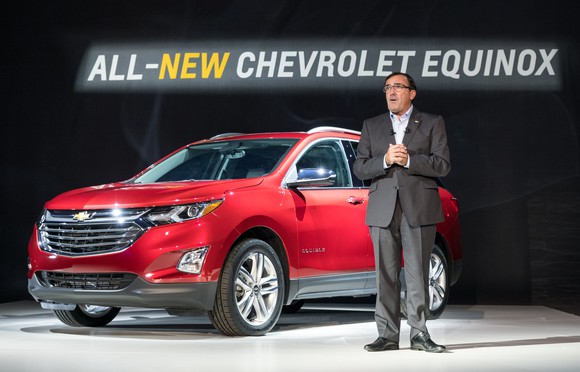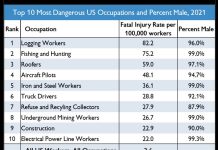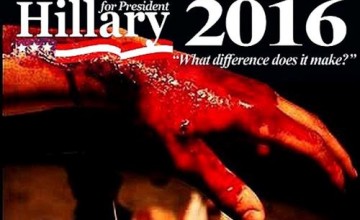Just not VW’s diesels.
The German automaker, if not kaput, has tapped out of that market to focus – mea culpa! – on electric cars (which will render the company kaput, if they’re serious).
Which means there are currently no affordable diesel-powered new cars available on the market, as VW was the only automaker selling them.
Now it looks like GM will be selling them.
Except maybe not.
The affordable part, I mean.
There are at least two on deck – a diesel powered version of the Chevy Cruze sedan (coming in 2017) and a diesel-powered version of the Chevy Equinox, which is a compact crossover SUV. It’s on deck for the 2018 model year and will probably debut sometime next summer.
These two pending join the already available diesel-powered Chevy Colorado and GMC Canyon pick-ups, which are the only pick-ups in their class available with diesel engines.
So, that’s three – with probably more on deck given that the 1.6 liter diesel engine slated for the Cruze and Equinox could be used in half a dozen other GM models, if the market shows interest.
But will it?
A lot depends on the price of gas when these diesels become available. If regular unleaded is still going for about $2 a gallon, making the case for buying a diesel engine for the sake of economy will be a hard case to make.
Consider the pending Equinox diesel.
It will probably be capable of 40 MPG on the highway and high 20s in city driving. This is definitely better than the current Equinox’s 20 city, 28 highway (with the 2.4 liter gas engine). But not spectacularly so.
Meanwhile, how much will you have to pay for the diesel?
GM – unlike VW – has (so far) only offered a diesel option in “loaded” versions of whatever the vehicle happens to be. The Chevy Cruze, for instance. It offered a diesel through the 2015 model year. But you had to buy a loaded 2LT trim ($23,270) and then buy the diesel (a $2,390 option) which brought the sticker price to $25,660 vs. $16,170 for the base trim Cruze.
It’s the same story with the Colorado/Canyon pick-ups. Before you can buy the diesel engine, you have to buy the more expensive four-door (crew cab) version and the higher LT or Z71 trims – which start at $27,920 (LT) before adding the diesel engine – which adds another almost $5k to the vehicle’s price tag.
You’re now well into the $30k range.
Meanwhile, you can buy a base extended cab (and gas-engined) Colorado pick-up for $20,100. It hasn’t got the pulling power the diesel’s got (just 3,500 pounds vs. 7,000 for the diesel) but the mileage is dead heat: 20/27 for the gas four cylinder engine vs. 20 city, 29 highway for the turbo-diesel engine.
VW’s policy was to sell inexpensive (not “loaded” versions) of its diesel-powered cars. You could, for example, buy a diesel-engined Jetta sedan (a rival of the Cruze) for $21,640. It didn’t have all the bells and whistles, but it did make a lot of economic sense.
Just over $21k – and 46 MPG on the highway.
No one else – including GM – offered anything like it.
And now, of course, no one offers anything like it.
This includes GM.
Which will likely continue the practice of bundling the diesel engine with higher trims – in order to hide the higher cost of the Uncle complaint diesel. To take people’s minds off that – to get them to not think too much about the economics – by getting them to think about the nice stereo, the seat heaters and maybe the leather seats, too.
Otherwise, diesels are a hard sell.
VW’s diesels sold well because they cost less overall. Their comparatively low sticker price and their high mileage made the case. But this was only achievable – apparently – by “cheating” on Uncle’s emissions tests. The additional gear (especially, urea injection) needed to pass the tests adds to the cost – and reduces efficiency.
This goes for the vehicles themselves as well as the fuel – which must be (per federal mandate) Ultra Low Sulfur diesel fuel. Which costs more to make than regular unleaded gas, which is why diesel costs more to buy than regular unleaded.
It sometimes costs more than premium unleaded.
Before federal ULS diesel requirements, diesel cost less than regular unleaded. It also took you farther. Diesel mileage – the new stuff – is not that great, in part because of the less-efficient fuel and in part because the Uncle-compliant engines aren’t as fuel-sippy as they could be.
Heck, they’re not even as fuel-sippy as they used to be.
Before ULS fuel and before Uncle’s various fatwas, 50 MPG diesels were available (and still are, in Europe). Whether they were “clean” (or at least “clean” enough) is certainly debatable. But their economics were beyond reproach.
Maybe there ought to be a “conversation” – as it’s styled in these touchy-feely times – about sensible policy with regard to diesel engines. How clean is clean enough? At what point does “clean” become too expensive for a diesel engine to make economic sense?
Very few people – certainly, even fewer in the media – grok let alone can explain the EPA’s emissions rigmarole. Can you say Tier 2 Bin 3? Have any clue what that might mean? Does anyone know how much pollution, in real terms, was actually “emitted” by the “cheating” diesels and what, precisely, this means in terms of the meaningful effect – if any – on either air quality or people’s health?
These are questions that demand answers – and explanations. People have a right to know what they’re being forced to pay for – and why.
The why being more than “just because.”
There needs to be a better reason than that for EPA’s making diesels cost-prohibitive to buy and not particularly economic to drive.
GM’s strategy – discreetly bundling these higher-cost but Uncle-complaint diesels with other features and nicer trim packages – is understandable.
But it’d be better if we could have economically sensible diesels.
You know, like VW used to make.
EPautos.com depends on you to keep the wheels turning! Clovers hate us!
Goo-guhl blackballed us!
Will you help us?
Our donate button is here.
If you prefer not to use PayPal, our mailing address is:
EPautos
721 Hummingbird Lane SE
Copper Hill, VA 24079
EPautos stickers – new design, larger and magnetic! – are free to those who send in $10 or more to support the site.












This will sound like a conspiracy theory, but could an additional “piling on” reason for destroying VW was their failure to unionize in Tennessee? This would also be to the benefit of the UAW, the other half of “government” in Government Motors.
After all, the UAW has been wanting to get a hold in the Southern states for a very long time. Seeing VW, which is always unionized, try to open a plant there, would make it finally happen. VW’s home union insists on unionization. Even GM’s home unions can’t do that.
Is it probably perhaps the diesel is a loss leader (or money loser) and they make up for it with higher margin trim levels. VW did some of that with the TDI. For example, I have a ’14 Jetta wagon 2.5S. Which is basically a stripped car. I looked hard at the TDI, but it was $3k – $4k more. In addition to the engine, it had leather seats, aluminum wheels and tinted glass. If I could have got just the engine in a Jetta S model, then maybe I would have bought it.
they are trying to destroy GM’s competition being it is part of the govt now also went after Toyota fining them an obscene amount of money. when are the CEO’s of these companies gonna grow a pair?? they can state GM killed over 50 people and got away with it
Very true, SPQR…
See today’s rant, here: http://ericpetersautos.com/2016/09/28/berias-technique-applied-vw/
The problem with diesel engines in the Colorado/Canyon is the price running up to almost full size pickups that are more capable in every way. Why pay 37 grand for a diesel Colorado, when you can pay 38 for a Silverado 2500 and get only 3-4 mpgs less? Even the 1500 will pull more, haul more and be more comfortable. You are talking 1-3 mpgs difference there.
Ever since uls diesel and tier 4, diesels don’t make any sense on a vehicle less than a 3/4 ton. And they only make sense there if you are towing 10,000 lbs for over 30 percent of your driving, at a minimum.
Then think about resale value. Silverados sell for an obscene amount, even with high miles, while a Colorado you probably couldn’t recoup half of your initial purchase price regardless of miles and usage.
True. I can’t see how it makes any sense to buy the midsized trucks unless you are talking about a tacoma. At least you will get resale out of it. But it’s not near as capable as a full size truck.
I was getting OR water from the windmill recently and there was this crewcab pickup that wasn’t a couple feet taller than me. I finally realized it was a GMC Canyonero or WTF ever they call them. The owner seemed to love it(woman, mid 30’s). It appeared to be the same size truck as most Silverado’s I had, probably had a greater tow capacity and much more power. But I won’t buy one for the same reason I won’t buy any new pickup…..I can’t work on them, or at least I can’t trouble shoot them.
Hi Eight,
I may have found a Candidate locally… ’84 El Camino Conquista… black and silver. Decent paint, decent interior… have not been able to hear it run much less drive it. I think it has a 305 but I’m not certain. Guy is asking $4k… I will try to get some pics.
eric, that’s probably a good pickup although it seems expensive, at least for my neck of the woods but then again, that greatly depends on the shape it’s in. A good transmission and engine in a good body is probably worth that if the a/c works or doesn’t need to much to do so.
A friend had a ’76 Classic that died in a head-on with a Vista Cruiser. 9 people in the Olds and 3 in the Elco and everybody went to the hospital but no fatalities, so much for air bags.
He bought a 79 or 80 I think. I thought they probably wouldn’t have any nuts but it surprised both of us. Oh, the 305 sucked but he put HEI and a different carb and duals so It picked it up quite a bit. He drove it to the day he died in 2002 and used it every day for a work truck. He had an anti-roll bar on the rear that wasn’t bolted at the ends but worked well except for the noise of it clicking. He drove it to the point the seat was used up. I see an 80’s something frequently that is an SS with black stripes on top over red. It looks good, been restored at least paint-wise and is a daily driver. You can haul plywood on top of the endgate and strap it down. I installed some hasp looking things inside my bed that worked really well. I’d rather haul it on top of the endgate than with the endgate down. I do a fair amount of dirt road and gravel will eat your endgate if you do much of that. Good luck, hope it’s a winner.
I’d go for the Ridgeline myself.
I really like that it can take a 4×8 sheet flat. And it costs about $5k less than a diesel-powered Canyon.
GM killed the diesel once, 35 years ago, with their 350 “diesel”….now, GM teamed up with Uncle will surely bury it!
These modern “diesels” completely obliterate all of the advantages of having a diesel, except perhaps for the extra torque for towing- but the reliability, simplicity, and economy are long gone.
Gone are the days when a diesel would get 50% better mileage than a gas job. Gone are the days when if the battery was dead, you could pop the clutch and still run your diesel all day… Gone are the days of diesels being nearly maintenance-free, and of being able to run on waste oil/veggie oil/kerosene, etc.
Today’s diesels are delicate high-tech money pits. Contaminate the fuel, and you may be looking at a high-pressure pump and full set of injectors replacement to the tune of $5-$6K.
Blow the turbo? May as well junk your vehicle if it’s out of warranty, ’cause that turbo’ll cost a few grand, and the engine’ll have to come out, or half the body’ll have to be takeb off the chassis to change it.
Look’it them Ford 6.4’s- freaking 150K mile disposable injuns. I get twice that out of an old lo-tech gas injun.
The fat lady is singing….
At the current rate, the fat lady is singing on mass market internal combustion engines altogether. We’ll be lucky to be left with a choice between a hybrid and full-electric. Current hybrids don’t meet EPA fatwas, so most of us might be forced into electric cars. Naturally, the electric grid can’t take this level of draw, so we’ll have them to go along with our rolling blackouts.
Hi OP,
If they push this – the electric agenda – it will require that they also outlaw IC cars already in people’s hands (as has been effectively done already in Paris and other such places) because most people will not be able to afford to buy an EV and will “cling” to their “dirty” IC cars….
I’m clinging to my cheap, dirty car.
Uncle is patient. They don’t need to ban IC cars, they’ll eventually wear out or get crashed, and the only replacement options will be electric.
Hi OppositeLock,
(I notice you are missing from quite a few vehicles lately. How much weight did they save by eliminating you?)
You say, “Uncle is patient.”
At least the fabian socialists are.
I like the wolf in sheep’s clothing coat of arms, I think it would look better as a car logo than their tortoise.
https://en.wikipedia.org/wiki/File:Fabian_Society_coat_of_arms.jpg
https://en.wikipedia.org/wiki/File:Fabian_tortoise.gif
Although Uncle is patient, just like the tortoise, when Uncle strikes, he too strikes hard.
Some might be wondering why I would bring up Fabian socialism and their symbology on Eric’s automobile site.
There is a reason why Eric does not have to read, from cover to cover, every “Moby Dick” owner’s manual before he drives away on his tests. That reason is standardization.
All the little symbols on every car Eric tests are all the same. “From alerting drivers to tyre inflation problems and engine failure, or when to add fuel to the tank, the universal language of information symbols used in cars is contained in a new International Standard.”
If “ multiple, conflicting symbols were used in vehicles”, Eric would have to study each and every “Moby Dick” sized manual before he could even start the vehicle.
Oh, the humanity.
But, in this brave new world in which we live in, we can all “Thank Ford” that our automobiles have been standardized.
Well, not exactly. Aldous Huxley’s Brave New World took place in 632 A. F. (After Ford). In reality, we live in 69 A. F. So who, in reality, do we have to thank for this “universal language of information symbols used in cars” that makes our lives so much better?
Julian Huxley, Aldous Huxley’s older brother is THE GUY who paved the way for the standardization of our everyday lives. He originated the United Nations Education, Scientific, and Cultural Organization or UNESCO. Under the direction of Julian Huxley, UNESCO gave us the International Organization for Standardization. Also Known As the ISO. (Yes, it should be IOS, but iso is Greek for “same” and these folks do want for us to all be the same.)
ISO 2575 Road vehicles – Symbols for controls, indicators and tell-tales only covers the color and artwork for 350+ symbols in our cars. ISO 26000, or ISO SR is the International Standard for Social Responsibility. ISO SR is not yet mandatory as it was first published in 63 A. F. or 2010.
Since ISO 26000 is still voluntary and VW has no way of being certified as being ISO 26000 compliant, the question arises concerning VW’s or even GM’s meeting International Standards for Social Responsibility. Or any other ISO standards like ISO 9001 or the ISO 14001.
Roger Gareth Frost thinks the joke might be on us, “The operation conformed to procedures and was a success. Unfortunately, the patient died.” http://asia.nikkei.com/Viewpoints/Viewpoints/ISO-silent-over-Volkswagen-certifications
Mr. Frosts statement makes me wonder if there is an ISO standard for press releases after police shootings
True, Opp. It’s really a fartwar against driving, period. What?! Autonomous sentient beings having the ability to go wherever they choose?! Can’t have that! Herd ’em into the cities and let ’em ride buses and only go to work or indoctrination camp!
Fartwar, good one. If only they were that harmless, even if unpleasant.
Well, they are waged by gas-bags….. 😀
A friend wasn’t able to afford that uber-expensive starter for his Powerstroke. He lived on the edge of a sharp drop, parked it in the driveway headed down. He and we both used it like it was fine, let it idle while we weren’t near a hill and it never let us down. He finally replaced the starter but it was almost like it wasn’t as good anymore.
I used to get a call from my parents(my mother)asking me to come home from college to start the pickup. That old ’55 must have had the same batteries for a couple decades. it had one chance to start and I seemed to be the only one who could manage it. It was always one of those difficult things. It would insult them for me to start it, move it and leave so I had to miss some “great” party every time. What a shame I couldn’t ruin my liver and almost get caught doing something I shouldn’t…..and other people saw it the same way. My parents knew I’d be hauling some girl with me and didn’t give me a hard time. People were straighter in a way back then but always accommodating. I’d go somewhere and meet parents who had no idea who I was and late or late the next day come in with their child accompanied by Cooter Brown and have something good for us to eat when we regained consciousness and could stand the thought of food, generally after the hair of the dog. It made dad’s think about the old days and mom’s think about the dad’s. At least our music wasn’t “You make my head go round, go round, when you go down when you go down down.” And I kinda like that song so what does it make me? Wish I were young again?
Nunzio, you do realize Ford is the only one that has to remove the body to work on the engine don’t you? A friend had a 6 L Ford and of course the head gaskets began to leak. The dealer kept giving him the runaround but he was a mechanic and finally told them engines don’t use coolant and this was happening to everyone we knew who had one. He leaves it with the Ford dealer. He comes back a week later and finds it scattered all over…..just to replace head gaskets. I’d always wondered and had asked people and then we found out.
I always thought those 350 diesels were junk but they’re highly valued as racing engines. Most of the problem turned out to be GM going cheap and not having a good fuel filter. I can attest to having the worst fuel of my life back then. Shops were overwhelmed with bad running vehicles of every sort and it was always water in the fuel, gas and diesel. I never saw so much water come out of filters and separators on diesels and just used a product to diffuse the water back then on my gas engines. Current vehicles would be ruined by it now. People were cutting fuel lines and putting in water separators with glass bowls and it was an unholy bunch of crap in them. Also put big inline filters past the separators. I got anal about filters during that era and have stayed that way.
Yeah, the diesel was basically a thick walled Old’s 350. You could convert them back to gas and stick a blower on them and crank the boost way up and not have issues like the blown gas blocked Old’s V8s.
The other question is just how is GM going to sell the diesel? Looking at the fuel economy on the Canyon/Colorado, the reason to buy one is for the towing and torque, not because you get an extra MPG or two. People towing things is a big segment of the truck market. Are they going to offer a towing package for the Cruze? Are they going to educate the dealers and get them to really look at the diesel’s advantages? And, as Eric points out, will it be offered across multiple product lines, or just on the Cruise?
Because of the way VW did things, it was fairly easy to mate that engine to multiple production lines, including most Audis. That’s how you get the cost down, by reusing parts across platforms. How many engines does GM have? Is there really that much difference between them? I’m pretty sure VW group only has 3 engines, a 2.5L 4 cyl gasser, a 2.0L diesel and a 1.8L diesel (not available in the US). I know that this is near heresy for those of us who love antique GMs with their unique drivetrains, but in the current environment multiple engines is more of a liability than an advantage. Again, Eric has pointed out that even your basic transport vehicle has 0-60 times that are in line with 1960s muscle cars and most of the marketable changes to vehicles in the last 10 years or so have been in the interior.
People don’t look at engines these days. Manufacturers won’t even show naked engines anymore, lift up the hood and there’s a piece of lingerie covering up the good stuff. There’s a cable channel called Velocity, lots of “reality” shows about fixing up old cars. You never see anything newer than the 1970s in these shops, and lots of grey hair too. Most of these restorations involve swapping out the old plant and installing a crate engine, with throttle body injection and electronic ignition. Then actually work on the interior and the paint. Kids these days want electric self-driving vehicles. Then they can play driving games on their iPhones while heading to the coffee shop…